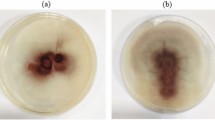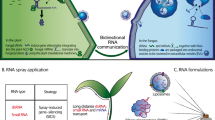Abstract
Key message
The C-terminal stretch in SbGPRP1 (Sorghum glycine-rich proline-rich protein) acts as an antimicrobial peptide in the host innate defense mechanism.
Abstract
Cationic antimicrobial proteins or peptides can either bind to the bacterial membrane or target a specific protein on the bacterial membrane thus leading to membrane perturbation. The 197 amino acid polypeptide of SbGPRP1 showed disordered structure at the N-terminal end and ordered conformation at the C-terminal end. In the present study, the expression of N-SbGPRP1, C-SbGPRP1, and ∆SbGPRP1 followed by antimicrobial assays showed potential antimicrobial property of the C-terminal peptide against gram-positive bacteria Bacillus subtilis and phytopathogen Rhodococcus fascians. The SbGPRP1 protein loses its antimicrobial property when the 23 amino acid sequence (GHGGHGVFGGGYGHGGYGHGYGG) from position 136 to 158 is deleted from the protein. Thus, it can be concluded that the 23 amino acid sequence is vital for the said antimicrobial property. NPN assay, SEM analysis, and electrolyte leakage assays showed potent antimicrobial activity for C-SbGPRP1. Overexpression of the C-SbGPRP1 mutant protein in tobacco followed by infection with Rhodococcus fascians inhibited bacterial growth as shown by SEM analysis. To determine if C-SbGPRP1 might target any protein on the bacterial membrane we isolated the bacterial membrane protein from both Bacillus subtilis and Rhodococcus fascians. Bacterial membrane protein that interacted with the column-bound C-SbGPRP1 was eluted and subjected to LC–MS/MS. LC–MS/MS data analysis showed peptide hit with membrane protein YszA from Bacillus subtilis and a membrane protein from Rhodococcus fascians. Isolated bacterial membrane protein from Bacillus subtilis or Rhodococcus fascians was able to reduce the antimicrobial activity of C-SbGPRP1. Furthermore, BiFC experiments showed interactions between C-SbGPRP1 and YszA protein from Bacillus subtilis leading to the conclusion that bacterial membrane protein was targeted in such membrane perturbation leading to antimicrobial activity.









Similar content being viewed by others
References
Agarwal T, Upadhyaya G, Halder T, Mukherjee A, Majumder AL, Ray S (2017) Different dehydrins perform separate functions in Physcomitrellapatens. Planta 245(1):101–118
Andolfo G, Ercolano MR (2015) Plant innate immunity multicomponent model. Front Plant Sci 6:987
Anjali B, Manisha T, Ajeet S (2016) Screening and isolation of antibacterial proteins/peptides from seeds of millets. Int J Curr Pharm Res 8(3):96–99
Bechinger B, Gorr SU (2017) Antimicrobial peptides: mechanisms of action and resistance. J Dent Res 96(3):254–260
Blank M, Shoenfeld Y (2008) Histidine-rich glycoprotein modulation of immune/autoimmune, vascular, and coagulation systems. Clin Rev Allergy Immunol 34(3):307–312
Bocca SN, Magioli C, Mangeon A, Junqueira RM, Cardeal V, Margis R, Sachetto-Martins G (2005) Survey of glycine-rich proteins (GRPs) in the Eucalyptus expressed sequence tag database (ForEST) Genet. Mol Biol 28:608–624
Boman HG (1995) Peptide antibiotics and their role in innate immunity. Annu Rev Immunol 13:61–92
Bradford MM (1976) A rapid and sensitive method for the quantitation of microgram quantities of protein utilizing the principle of protein-dye binding. Analytical Biochem 72(1–2):248–254
Broekaert WF, Cammue BP, De Bolle MF, Thevissen K, De Samblanx GW, Osborn RW, Nielson K (1997) Antimicrobial peptides from plants. Crit Rev Plant Sci 16(3):297–323
Chen X, Zhang L, Wu Y, Wang L, Ma C, Xi X, Bininda-Emonds ORP, Shaw C, Chen T, Zhou M (2018) Evaluation of the bioactivity of a mastoparan peptide from wasp venom and of its analogues designed through targeted engineering. Int J Biol Sci 14:599–607
Chisholm ST, Coaker G, Day B, Staskawicz BJ (2006) Host-microbe interactions: shaping the evolution of the plant immune response. Cell 124(4):803–814
Cornelis K, Ritsema T, Nijsse J, Holsters M, Goethals K, Jaziri M (2001) The plant pathogen Rhodococcus fascians colonizes the exterior and interior of the aerial parts of plants. Mol Plant Microb Interact 14(5):599–608
Croes S, Weyens N, Colpaer J, Vangronsveld J (2015) Characterization of the cultivable bacterial populations associated with field grown Brassica napus L.: an evaluation of sampling and isolation protocols. Environ Microbiol 17(7):2379–2392
Dellaporta SL, Wood J, Hicks JB (1983) A plant DNA minipreparation: version II. Plant Mol Biol Report 1(4):19–21
Dinneny JR, Long TA, Wang JY, Jung JW, Mace D, Pointer S, Barron C, Brady SM, Schiefelbein J, Benfey PN (2008) Cell identity mediates the response of Arabidopsis roots to abiotic stress. Science 320:942–945
Dos Santos-Silva CA, Zupin L, Oliveira-Lima M, Vilela L, Bezerra-Neto JP, Ferreira-Neto JR, Ferreira J, de Oliveira-Silva RL, Pires CJ, Aburjaile FF, de Oliveira MF, Kido EA, Crovella S, Benko-Iseppon AM (2020) Plant antimicrobial peptides: state of the art, in silico prediction and perspectives in the omics era. Bioinform Biol Insights 14:1177932220952739
Feng Y, Peng H, Liang S (2011) Molecular analysis of the PGYRP (proline-, glycine-and tyrosine-rich protein) gene family in soybean. Mol Biol Rep 38:2739–2750
Fischer ER, Hansen BT, Nair V, Hoyt FH, Dorward DW (2012) Scanning electron microscopy. Curr Protoc Microbiol. https://doi.org/10.1002/9780471729259.mc02b02s25
Gimenez E, Salinas M, Manzano-Agugliaro F (2018) Worldwide research on plant defense against biotic stresses as improvement for sustainable agriculture. Sustainability 10(2):391
Goethals K, Vereecke D, Jaziri M, Van Montagu M, Holsters M (2001) Leafy gall formation by Rhodococcus fascians. Annu Rev Phytopathol 39(1):27–52
Halder T, Agarwal T, Ray S (2016) Isolation, cloning, and characterization of a novel Sorghum dehydrin (SbDhn2) protein. Protoplasma 253(6):1475–1488
Halder T, Upadhyaya G, Roy S, Biswas R, Das A, Bagchi A, Agarwal T, Ray S (2019) Glycine rich proline rich protein from Sorghum bicolor serves as an antimicrobial protein implicated in plant defense response. Plant Mol Biol 101(1–2):95–112
Horsch RB, Fry JE, Hoffmann NL, Eichholtz D, Rogers SG, Fraley RT (1985) A simple and general method for transferring genes into plants. Science 227:1229–1231
Huan Y, Kong Q, Mou H, Yi H (2020) Antimicrobial peptides: classification, design, application and research progress in multiple fields. Front Microbiol 11:582779
Iqbal Z, Iqbal MS, Hashem A, Abd Allah EF, Ansari MI (2021) Plant Defense Responses to Biotic Stress and Its Interplay with Fluctuating Dark/Light Conditions. Front Plant Sci 12:631810
Krogh A, Larsson B, von Heijne G, Sonnhammer EL (2001) Predicting transmembrane protein topology with a hidden Markov model: application to complete genomes. J Mol Biol 305(3):567–580
Lee BH, Henderson DA, Zhu JK (2005) The Arabidopsis cold responsive transcriptome and its regulation by ICE1. Plant Cell 17:3155–3175
Letunic I, Bork P (2018) 20 years of the SMART protein domain annotation resource. Nucleic Acids Res 46(1):493–496
Letunic I, Khedkar S, Bork P (2021) SMART: recent updates, new developments and status in 2020. Nucleic Acids Res 49(1):458–460
Li J, Hu S, Jian W, Xie C, Yang X (2021) Plant antimicrobial peptides: structures, functions, and applications. Bot Stud 62(1):1–15
Liu X, Wang X, Yan X, Li S, Peng H (2020) The glycine- and proline-rich protein AtGPRP3 negatively regulates plant growth in Arabidopsis. Int J Mol Sci 21(17):6168
Marty I, Monfort A, Stiefel V, Ludevid D, Delseny M, Puigdomenech P (1996) Molecular characterization of the gene coding for GPRP, a class of proteins rich in glycine and proline interacting with membranes in Arabidopsis thaliana. Plant MolBiol 30:625–636
Matsushima N, Creutz CE, Kretsinger RH (1990) Polyproline, beta-turn helices. Novel secondary structures proposed for the tandem repeats within rhodopsin, synaptophysin, synexin, gliadin, RNA polymerase II, hordein, and gluten. Proteins 7(2):125–155
Murashige T, Skoog F (1962) A revised medium for rapid growth and bio assays with tobacco tissue cultures. Physiol Plant 15(3):473–497
Nakahara KS, Kitazawa H, Atsumi G, Choi SH, Suzuki Y, Uyeda I (2011) Screening and analysis of genes expressed upon infection of broad bean with Clover yellow vein virus causing lethal necrosis. Virol J 8(1):1–6
Ojcius DM, Young JDE (1991) Cytolytic pore-forming proteins and peptides: is there a common structural motif? Trends Biochem Sci 16:225–229
Pathan AK, Bond J, Gaskin RE (2010) Sample preparation for SEM of plant surfaces. Mater Today 12:32–43
Peng H, Feng Y, Zhang H, Wei X, Liang S (2012) Molecular Cloning and Characterisation of Genes Coding for Glycine- and Proline-Rich Proteins (GPRPs) in Soybean. Plant MolBiol Rep 30:566–577
Pertry I, Václavíková K, Gemrotová M, Spíchal L, Galuszka P, Depuydt S et al (2010) Rhodococcus fascians impacts plant development through the dynamic fas-mediated production of a cytokinin mix. Mol Plant Microbe Interact 23(9):1164–1174
Pommerrenig B, Barth I, Niedermeier M, Kopp S, Schmid J, Dwyer RA (2006) Common Plantain. A collection of expressed sequence tags from vascular tissue and a simple and efficient transformation method. Plant Physiol 142:1427–1441
Radhika V, Ueda N, Tsuboi Y, Kojima M, Kikuchi J, Kudo T, Sakakibara H (2015) Methylated cytokinins from the phytopathogen Rhodococcus fascians mimic plant hormone activity. Plant Physiol 169(2):1118–1126
Sachetto-Martins G, Franco LO, de Oliveira DE (2000) Plant glycine-rich proteins: a family or just proteins with a common motif? BiochimicaetBiophysicaActa (BBA)-Gene Structure and Expression. Biochimica Et Biophysica Acta (BBA) Gene Struct Expr 1492(1):1–14
Thomas S, Karnik S, Barai RS, Jayaraman VK, Idicula-Thomas S (2009) CAMP: a useful resource for research on antimicrobial peptides. Nucleic Acids Res 38:774–780
Vandeputte O, Öden S, Mol A, Vereecke D, Goethals K, Jaziri El et al (2005) Biosynthesis of auxin by the gram-positive phytopathogen Rhodococcus fascians is controlled by compounds specific to infected plant tissues. Appl Environ Microbiol 71(3):1169–1177
Waghu FH, Gopi L, Barai RS, Ramteke P, Nizami B, Idicula-Thomas S (2014) CAMP: Collection of sequences and structures of antimicrobial peptides. Nucleic Acids Res 42(1):1154–1158
Waghu FH, Barai RS, Gurung P, Idicula-Thomas S (2015) CAMPR3: a database on sequences, structures and signatures of antimicrobial peptides. Nucleic Acids Res 44(1):1094–1097
Wang G, Li X, Wang Z (2015) APD3: the antimicrobial peptide database as a tool for research and education. Nucleic Acids Res 44(1):1087–1093
Waadt, Rainer, Lena K., Schmidt Marc, Lohse Kenji, Hashimoto Ralph, Bock Jörg, Kudla (2008) The Plant Journal 56(3):505–516. https://doi.org/10.1111/j.1365-313X.2008.03612.x
Xu K, Huang X, Wu M, Wang Y, Chang Y, Liu K, Zhang J, Zhang Y, Zhang F, Yi L, Li T, Wang R, Tan G, Li C, Davis KR (2014) A rapid highly efficient and economical method of agrobacterium-mediated in planta transient transformation in living onion epidermis. PLoS ONE 9(1):e83556. https://doi.org/10.1371/journal.pone.0083556
Acknowledgements
We sincerely express our wholehearted thanks to DST- FIST and UGC CAS for instrumental facilities of Department of Botany, University of Calcutta. We thank CRNN-University of Calcutta for their support regarding scanning electron microscopy. We are grateful to Souvik Roy, Bose Institute for his support with the LC-MS/MS facility.This work is supported by grants to SR from the Council of Scientific and Industrial Research, Government of India (38(1402)/15/EMR-II dated 14.08.2015)).ShRandAD thank the University Grants Commission, Government of India for Research Fellowship (Sanction No.(2061530629 dated 10/12/2015), (813/(CSIR-UGC NET DEC. 2016) respectively). TA and TH thank the Council of Scientific and Industrial Research Institute Fellowship (Sanction No.(09/0028(11361)/2021-EMR-I), (09/ 0028(11939)/2021-EMR-I) respectively). GU thanks the Department of Science and Technology, Government of India for research fellowship.(Sanction No. DST/INSPIRE Fellowship/2015/IF150503).
Funding
Council for Scientific and Industrial Research,38(1402)/15/EMR-II dated 14.08.2015),Sudipta Ray
Author information
Authors and Affiliations
Contributions
SR abstracted and administrated the experiments; SR, TA, AD, TH, and GU performed most of the experiments; SR and TA designed the experiments and analyzed the data; SR conceived the project; SR and TA wrote the manuscript. SR supervised and complemented the writing. All authors read and approved the manuscript.
Corresponding author
Ethics declarations
Conflict of interest
The authors have no conflicts of interest to declare.
Additional information
Publisher's Note
Springer Nature remains neutral with regard to jurisdictional claims in published maps and institutional affiliations.
Supplementary Information
Below is the link to the electronic supplementary material.
Rights and permissions
Springer Nature or its licensor (e.g. a society or other partner) holds exclusive rights to this article under a publishing agreement with the author(s) or other rightsholder(s); author self-archiving of the accepted manuscript version of this article is solely governed by the terms of such publishing agreement and applicable law.
About this article
Cite this article
Roy, S., Agarwal, T., Das, A. et al. The C-terminal stretch of glycine-rich proline-rich protein (SbGPRP1) from Sorghum bicolor serves as an antimicrobial peptide by targeting the bacterial outer membrane protein. Plant Mol Biol 111, 131–151 (2023). https://doi.org/10.1007/s11103-022-01317-1
Received:
Accepted:
Published:
Issue Date:
DOI: https://doi.org/10.1007/s11103-022-01317-1




